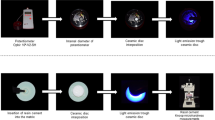Abstract
The main objective of the study was to recognize the effect of ceramic thickness and luting agent on the extent to which the restoration masks color variations that may be present in the underlying dental structure. Two pressable ceramics were used: Lithium disilicate reinforced (IPS e.max- Ivoclar Vivadent) and Leucite reinforced (Cergo- Dentsply). Fifteen ceramic discs were manufactured from each ceramic and divided into three groups, according to the thickness (0.5, 1, 1.5 mm). To simulate the color of a dark underlying dental structure, background discs, color C3, with 20 mm diameter, were made using resin composite. The ceramic discs with varying thicknesses were seated on the dark background of the resin composite with either resinous opaque cement or resinous cement. The color parameters were determined by the CIE Lab system of colors using a spectrophotometer and color differences (ΔE) were calculated. The results were then statistically analyzed, using ANOVA test and Tukey HSD test. The ΔE values of both ceramic systems were affected by both the luting agent and the ceramic thickness (P < 0.05). The use of an opaque luting agent resulted in an increase of the ΔE* values for all ceramics tested, regardless of the thickness. For the 1.5-mm thick veneers, higher values in the color parameters were obtained for both ceramic materials. The color masking ability of ceramics used for laminate veneers is significantly affected by the thickness of the ceramic and the shade of the luting agent used.



Similar content being viewed by others
References
Peumans M, Van Meerbeek B, Lambrechts P, Vanherle G (2000) Porcelain veneers: a review of the literature. J Dent 28(3):163–177
Peumans M, Van Meerbeek B, Lambrechts P et al (1997) The 5-year clinical performance of direct composite additions to correct tooth form and position. Clin Oral Invest 1(1):12–18
Volpato CAM, Fredel MC, Philippi AG, Petter CO (2011) Ceramic materials and color in dentistry. Published by InTech. Sept 2011, pp. 155–175
Turgut S, Bagis B (2013) Effect of resin cement and ceramic thickness on final color of laminate veneers: an in vitro study. J Prosthet Dent 109(3):179–186
Pippin DJ, Mixson MJ, Soldan-Els AJ (1995) Clinical evaluation of restored maxillary incisors: veneers versus PFM crowns. J Am Dent Assoc 126:1523–1529
De Azevedo Cubas GB, Camacho GB, Demarco FF, Pereira-Cenci T (2011) The effect of luting agents and ceramic thickness on the color variation of different ceramics against a chromatic background. Eur J Dent 5(3):245
Dozic A, Kleverlaan CJ, Meegdes M, Zel JV, Feilzer AJ (2003) The influence of porcelain layer thickness on the final shade of ceramic restorations. J Prosthet Dent 90(6):563–570
Barath VS, Faber FJ, Westland S et al (2003) Spectrophotometric analysis of all-ceramic materials and their interaction with luting agents and different backgrounds. Adv Dent Res 17:55–60
Jorgenson MW, Goodkind RJ (1979) Spectrophotometric study of five porcelain shades relative to the dimensions of color, porcelain thickness, and repeated firings. J Prosthet Dent 42:96–105
Jarad FD, Griffiths CE, Jaffri M, Adeyemi AA, Youngson CC (2008) The effect of bleaching, varying the shade or thickness of composite veneers on final colour: an in vitro study. J Dent 36(7):554–559
Griffiths CE, Bailey JR, Jarad FD, Youngson CC (2008) An investigation into most effective method of treating stained teeth: an in vitro study. J Dent 36:54–62
Kürklü D, Azer SS, Yilmaz B, Johnston WM (2013) Porcelain thickness and cement shade effects on the colour and translucency of porcelain veneering materials. J Dent 41(11):1043–1050
Al-Ghazali N, Laukner J, Burnside G, Jarad FD, Smith PW, Preston AJ (2010) An investigation into the effect of try-in pastes, uncured and cured resin cements on the overall color of ceramic veneer restorations: an in vitro study. J Dent 38:e78–e86
Vichi A, Fraioli A, Davidson CL, Ferrari M (2007) Influence of thickness on color in multi-layering technique. Dent Mater 23(12):1584–1589
Chu F, Chow TW, Chai J (2007) Contrast ratios and masking ability of three types of ceramic veneers. J Prosthet Dent 98(5):359–364
Ozturk O, Uludag B, Usumez A, Sahin V, Celik G (2008) The effect of ceramic thickness and number of firings on the color of two all-ceramic systems. J Prosthet Dent 100:99–106
Author information
Authors and Affiliations
Corresponding author
Rights and permissions
About this article
Cite this article
Begum, Z., Chheda, P., Shruthi, C.S. et al. Effect of Ceramic Thickness and Luting Agent Shade on the Color Masking Ability of Laminate Veneers. J Indian Prosthodont Soc 14 (Suppl 1), 46–50 (2014). https://doi.org/10.1007/s13191-014-0362-2
Received:
Accepted:
Published:
Issue Date:
DOI: https://doi.org/10.1007/s13191-014-0362-2




